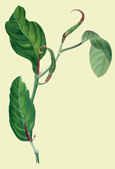| Latin Name | Piper longum Linn.(Piperaceae) |
| English Name | Indian long pepper |
| Sanskrit Names | Pippali, Magadhi, Kana, Ushana |
| Hindi Names | Pipal, Pipar |
 Distribution: It occurs in the hotter parts of India, from Central Himalayas to Assam, Khasi and the Mikir hills, the lower hills of Bengal, and the evergreen forests of the Western Ghats from Konkan to Travancore. It has also been recorded in the Car Nicobar Islands. Habit: P.l. is a slender aromatic climber with perennial woody roots. The stems are jointed; the leaves, ovate and cordate with broad rounded lobes at the base, entire and glabrous; the spikes, cylindrical, male spikes larger and slender; the fruits, ovoid and yellowish orange. Principle constituents: Piperine and Piplartine Indications: The fruits are used for diseases of the respiratory tract, viz. cough, bronchitis, asthma, etc.; as counter-irritant and analgesic when applied locally for muscular pains and inflammation and as general tonic and hematinic. It is known to enhance the bio-availability of food and drugs as well as being a carminative. Product range: Abana, Bonnisan, Geriforte |
|